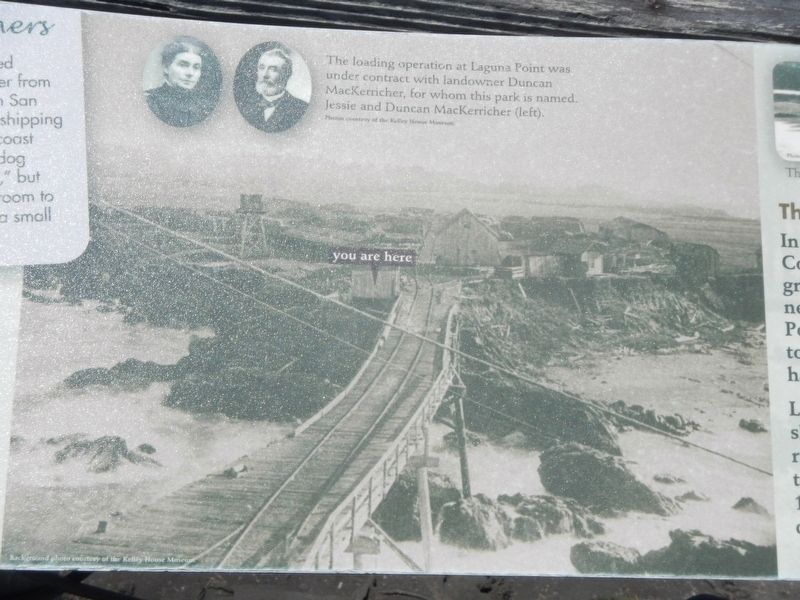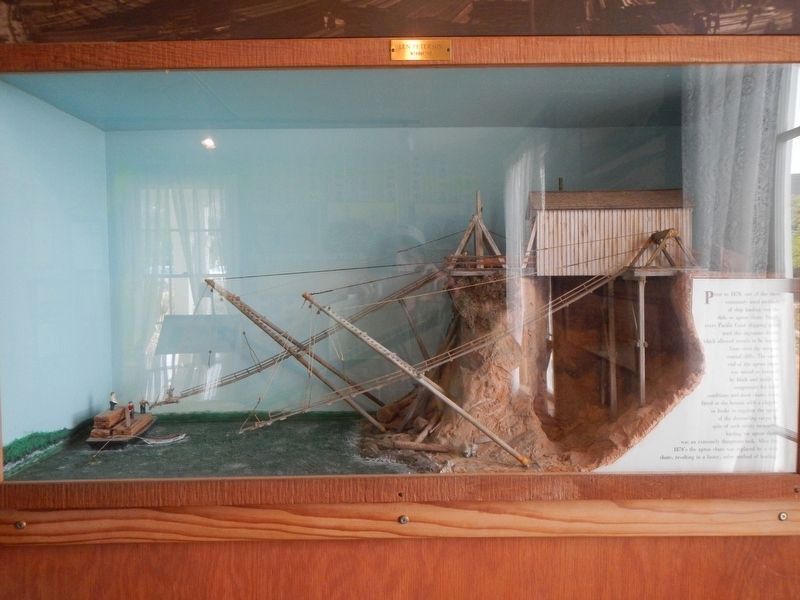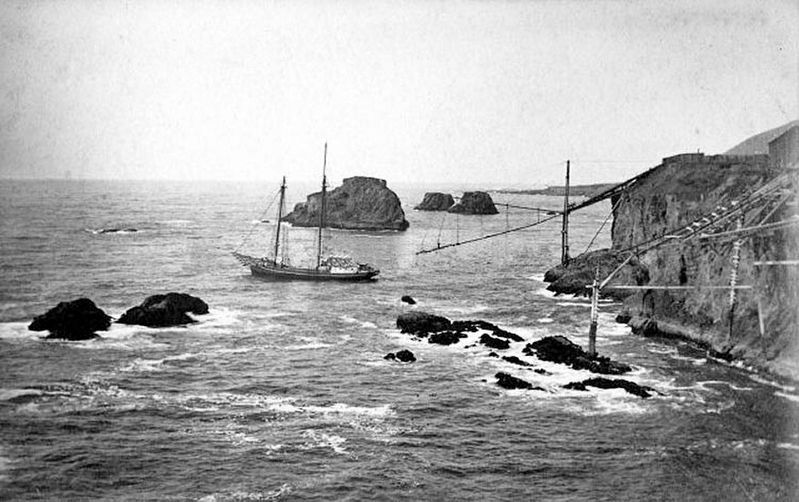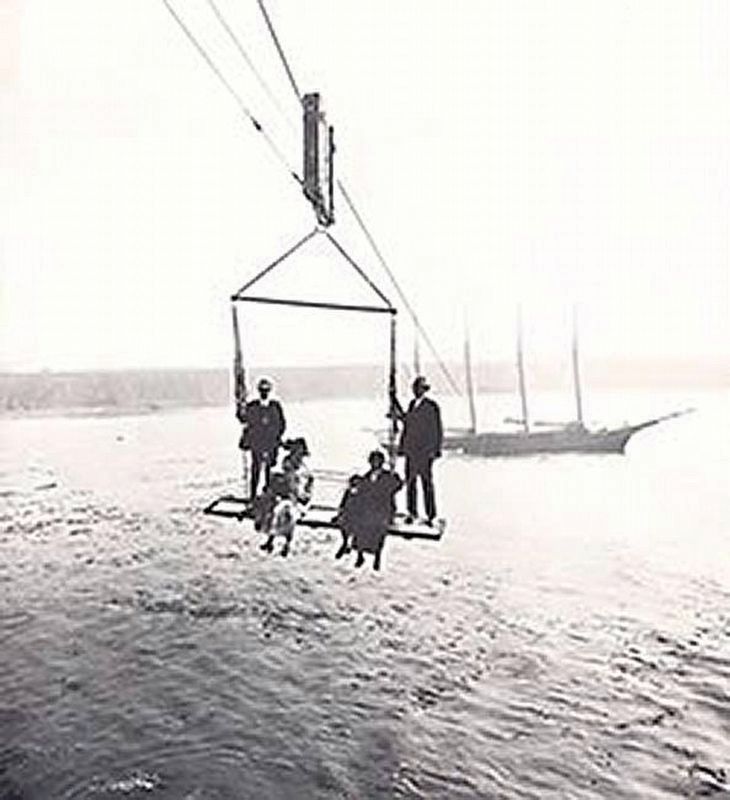Near Cleone in Mendocino County, California — The American West (Pacific Coastal)
Timber Years
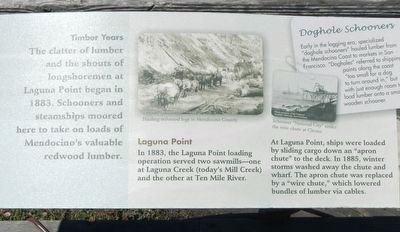
Photographed By Barry Swackhamer, July 22, 2016
1. Timber Years Marker, left section
Captions: (left to right) Hauling redwood logs in Mendocino County.; Schooner "National City" under the wire chute at Cleone.; The Cleone trestle was built for the railroad in1916.; Remnants of a berm to support the old haul road.
Laguna Point
In 1883, the Laguna Point loading operation served two sawmills - one at Laguna Creek (today's Mill Creek) and the other at Ten Mile River.
At Laguna Point, ships were loaded by sliding cargo down an "apron chute" to the deck. In 1885, winter storms washed away the chute and wharf. The apron chute was replaced by a "wire chute," which lowered bundles of lumber via cables.
The Tramway
In 1887, the Little Valley Lumber Company built a 2.5-mile-long, gravity-driven tramway from its mill near the town of Cleone to Laguna Point. Full rail cars coasted down hill to the shipping yard, and horses hauled them back to the mill.
Laguna Creek Mill and the tramway shut down in 1904. Although railroad ties and tanbark continued to travel out of Laguna Point until 1920, most lumber was shipped out of Fort Bragg.
From Railroad to Coast Trail
MacKerricher's coastal trail began as a logging railroad in 1916. In 1949, a road was built to transport logs by truck. The Lake Cleone railroad trestle burned down in the early 1960s. You can walk the same haul road today.
Doghole Schooners
Early in the logging era, specialized "doghole schooners" hauled lumber from the Mendocino Coast to markers in San Francisco. "Dogholes" referred to shipping points along the coast "too small for a dog to turn around in," but with just enough room to load lumber onto a small wooden schooner.
Erected by California State Parks.
Topics. This historical marker is listed in these topic lists: Industry & Commerce • Waterways & Vessels. A significant historical year for this entry is 1883.
Location. 39° 29.408′ N, 123° 48.103′ W. Marker is near Cleone, California, in Mendocino County. Marker is on Mill Creek Drive near Shoreline Highway (California Route 1). Touch for map. Marker is in this post office area: Fort Bragg CA 95437, United States of America. Touch for directions.
Other nearby markers. At least 8 other markers are within 3 miles of this marker, measured as the crow flies. Harvesting the Shore (about 300 feet away, measured in a direct line); Surrounded By Trees (approx. 2.7 miles away); Our Past Through Our Trash (approx. 2.8 miles away); The Weller House (approx. 3 miles away); First Baptist Church Bell (approx. 3 miles away); Dynamite Shack (approx. 3 miles away); Fort Building (approx. 3 miles away); Major William F. Mullen Freedom Tree (approx. 3.1 miles away).
More about this marker. This marker is located on the
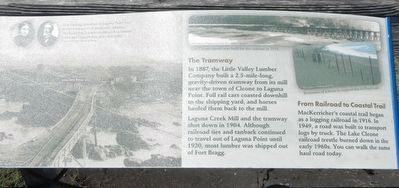
Photographed By Barry Swackhamer, July 22, 2016
2. Timber Years Marker, right section
Captions: (left to right) Hauling redwood logs in Mendocino County.; Schooner "National City" under the wire chute at Cleone.; The Cleone trestle was built for the railroad in1916.; Remnants of a berm to support the old haul road.
Also see . . .
1. West Coast lumber trade - Wikipedia. As late as the California Gold Rush, New England lumber was still carried 13,000 miles around Cape Horn to San Francisco. But that started to change when Captain Stephen Smith (of the bark George Henry) established one of the first west coast lumber mill in a redwood forest near Bodega, California, in 1843. The first lumber mill on the west coast was established by John B. R. Cooper in Rancho El Molino near present-day Forestville, California. By the mid-1880s, more than 400 such mills operated within the forests of California's Humboldt County and along the shores of Humboldt Bay alone. (Submitted on August 9, 2016, by Barry Swackhamer of Brentwood, California.)
2. Dog-hole ports - Wikipeidia. There were four major methods of loading ships at dog-holes: lightering, slide, apron or gravity chutes, wire or trapeze chutes, and wharfing. [5] At first shippers used lighters to ferry cargo out to anchored ships, but this was a slow process. By 1860 a gravity chute called an apron or slide chute was developed. It consisted of an A-frame on the bluff and an apron that could be adjusted to the height of the ships’ decks. Lumbermen sent down cargo from the bluff, which was as high as 150 feet, by the chute powered by gravity. (Submitted on August 9, 2016, by Barry Swackhamer of Brentwood, California.)
Credits. This page was last revised on August 9, 2016. It was originally submitted on August 9, 2016, by Barry Swackhamer of Brentwood, California. This page has been viewed 499 times since then and 29 times this year. Photos: 1, 2, 3, 4, 5, 6, 7. submitted on August 9, 2016, by Barry Swackhamer of Brentwood, California.
